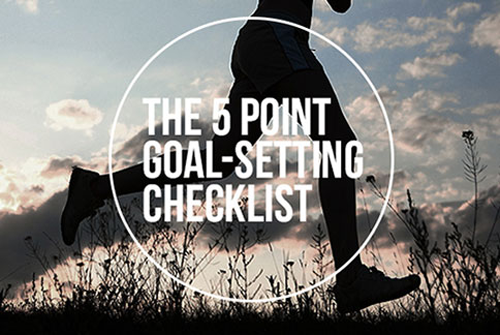What do you do when you set yourself a goal? Pray? Visualise achieving it? Tell all your mates so the pressure’s on not to make a goose of yourself? All these approaches have merit, but there are some very specific self-assessments you can make to put your goal more in your control.
The problem we see is that too much focus is put on the end goal and not enough thought goes into the process – that, and the fact that the goals can be very big, super-hairy, and ultra-audacious. Combined, these things set people up to aim for too much too soon, and they hurt or damage themselves physically. Worst, they get crushed mentally and their confidence is shot.
Of course, this is not the impression you get from magazines, TV, health media and many websites or social media. We see Debbie climbing Mt Everest three months after giving birth, planting a flag attached to her prosthetic leg on the summit. Next thing you know, you’ll be wondering why you’re thinking about climbing Mt Everest next year when you really should be riding up it on a unicycle this October.
Goals are very personal things that have to be tailored to your abilities, background, resources (including time!), and motivation for the goal. They can’t be influenced too much by anything or anyone else.
Effective goal-setting relies some very specific self-assessments you can make to put your goal more in your control, so that you know that you’ve done the best you can do while looking after your health. It’s just a matter of following a few key checks.
Work on your weaknesses
Don’t just do what you like or what you’re good at, do what you need.
It’s the runner who boasts about how many kilometres she does in a week, but never does interval training; the strength athlete who does lots of 2-inch bench press because he can pile on the weight and it looks fantastic; the footballer who will sprint with the ball but avoid tackling practice.
The need to work on weaknesses applies to any sport, but particularly sports with different disciplines, like triathlon, powerlifting, adventure racing – the top guys may not be the best at any one activity, but they have no major weakness, either. So find your weakness, work out what you need to improve it, and do it. As you fix one weaker area, something else will then be weaker by comparison – so it’s a never-ending quest.
Protect your vulnerable areas
When we set a goal and make a detailed plan, we rely on steady progress and improvement to take us to that goal.
In sports training, the most common thing that interrupts and reverses progress and improvement is injury, so athletes identify any part of their body that will be most at risk from injury. Part of this will be identifying areas that are at general risk from the activity, part of it is being aware of your own history and make-up. So, in the first case, a swimmer should know good warm-up and conditioning exercises for their shoulders, while someone in a sport involving will know that they need to pay extra attention to their glute and hamstring strength and flexibility if they have a history of hamstring injuries. In both cases, it’s also important to be realistic about how often and how much they can put these more fragile areas under strain. Protecting yourself from injury becomes more difficult when you do a contact sport, because you might not have much control over someone shoulder charging you like an angry rhino. You can take some preventative measures to protect yourself from some forms of contact. These include strengthening the core so that your body is less vulnerable under impact and developing more strength and flexibility in the supporting muscles around joints susceptible to impact injuries (e.g. knees, ankles, neck).
Your diet might be a vulnerable area. Maybe a consistently good eating plan comes under attack from work functions, dating, eating with family. Perhaps the problem is that you don’t want to cook or don’t know enough options for healthy meals, or maybe you eat for emotional reasons or out of boredom. If this is you, this is going to hurt your progress towards your goal like a baseball bat to the thighs. Not getting enough sleep or you have poor-quality sleep? Make that a baseball bat to the ankles.
Technique – it can always improve
Sometimes – and especially beyond a certain age – it becomes harder to improve your strength, fitness, speed or reaction time, but one thing you can always improve is your technique. No matter what sport you play, working on your technique can help your performance, improve your efficiency and make you less prone to injury or error. Even if you are happy with your technique and don’t want to change it, there will always be something you can work on to make it more consistent. Work on your cues, practice your actions blindfolded and watching yourself on video will all help.
Diet, like your training, tends to benefit from persistence and consistency, but again, there’s always something that you can improve. It’s not all about what you can remove from your diet, either. More training means that your body has a greater need for certain nutrients. It’s often easy to supercharge your nutrient intake with real food without big additions to total energy intake – although depending on your training and your diet, increasing calories might be exactly what you need. For many people, it’s best to cut out the step where you bombard your brain with rumours, Chinese whispers and marketing misinformation and go straight to a sports dietitian for advice.
Train your attitude
The scoreboard never counts anything you did in training. You might have done PB after PB, looked unbeatable and humiliated your training partners – but none of it matters unless you can learn to find that balance between nerves and excitement on the day of competition so you can replicate your best form. Don’t just accept the anxiety or overexcitement. Work out now how you’re going to deal with it. Try to anticipate any scenarios that might put you off your plan and work out how you’ll react – it will save you getting flustered on the day. Don’t be afraid to get advice – athletes tend to openly discuss physical or technical weaknesses, but are reluctant to spill all or get proper coaching on the mental side of performance.
For some people, the problem might be turning on mentally day after day of training. Sure, life gets in the way and you might have lots on your mind, or there could be a bunch of off-putting people around at training and Barry Manilow is blaring over the speakers. But guess what? On comp day, you might have lots of distractions too, and you won’t be able to tell the crowd to cheer for you or go away. You won’t be able to choose what music’s playing. You can’t be sure everything’s going to be perfect in your personal life or at work. All that ability to have a rifle barrel-like focus and fire up has to come from within. Get it right in training and it will be easier to do on comp day.
Get real about the conditions
You need to think to plan for and prepare for the conditions. I’m not just talking about the most likely conditions, but the variations that risk getting thrown in – don’t be one of those wusses who blame the fact that it rained in Summer for not finishing a race. Even with indoor sports and activities, the heat might be oppressive or the noise might be deafening. For some events, some of the significant variables might be with the playing surface (e.g. tennis, trail running – is it slippery? Soft? Hard?), the weather, variations in rules or officiating those rules, the time of day of the competition and even the opposition.
Just like the athlete, you need to plan ahead for all contingencies and come up with a substitute or work-around instead of an excuse. Do whatever you can to replicate the likely and the possible conditions of your goal event. Be prepared for the fact that this may come at the expense of your ‘normal’ training performance and even your results at minor competitions between now and your goal competition. Doesn’t matter. Keep your eyes on the prize.
A shorter version of this article was prepared for 2XU International.





